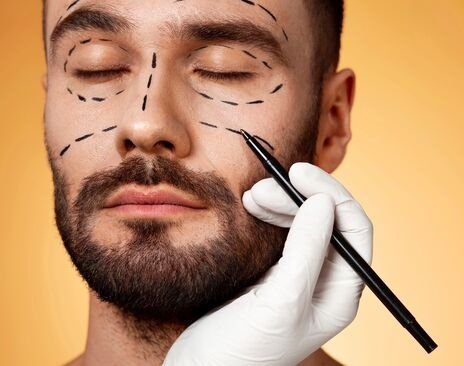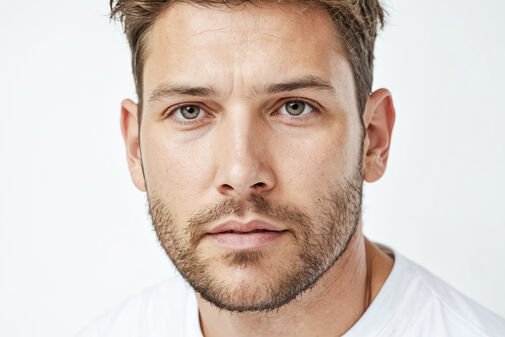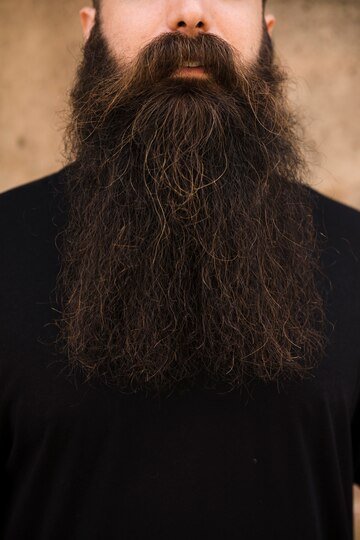You must have heard about hair transplants, which are very common nowadays. Maybe you or someone you know has undergone a hair transplant. One of my elder brothers has had a hair transplant, and he is very delighted with the result. Like hair transplants, beard transplants are also becoming popular day by day, as beards are now trendy and fashionable for men. Moreover, it is regarded as a masculine sign. Everyone wants a fuller, thicker beard, but not everyone gets these naturally in their desired way. Thus, beard transplant is being considered as a permanent solution. Read on to know in detail about beard transplants, and I hope almost all of your queries about beard transplants will be fulfilled after reading this blog fully.
Topics Covered
Toggle
What Is a Beard Transplant?
In simple terms, a beard transplant involves transferring hair or hair follicles from one part of your body to your facial area where a beard is non-existent. Hair or hair follicles are extracted from the Donor Area. Mostly, the donor area is the back of the head. A beard transplant gives a natural look to the beard on your face.
For a surgeon, there are two methods or approaches accessible. These procedures are called FUT (follicular unit transplantation) and FUE (follicular unit extraction).
Follicular Unit Extraction (FUE): In this technique, individual hair or hair follicles are taken from one part of the body or donor area (usually the back of the head). It is less painful. Also it has a quicker recovery time. It leaves tiny, barely noticeable scars.
Follicular Unit Transplantation (FUT): Using this method, the hair follicles are extracted from a tiny strip of skin or tissue that is cut from the back of your head. It can hurt more and take longer to recover from than FUE. It leaves a linear scar where the strip was taken.
Who Is Suitable for a Beard Transplant?
Whether you are suitable for a beard transplant or not will be decided by your doctor or surgeon. A thorough and detailed consultation is necessary and will help determine if you’re suitable for this procedure or not.
The doctor or surgeon will mainly check whether you have a good and healthy hair density in your donor area. As hair follicles are mainly transplanted from the back area of the head, it is necessary to have healthy hair follicles in that area. It is a good sign that most people or men have healthy hair growth on the back of their heads, even if they are bald on the top of their heads. These factors will be considered mainly by your surgeon.
Beard Transplant Procedure
During a thorough and detailed discussion with your surgeon, you’ll get to know the procedure of the beard transplant. During that conversation, your physician or surgeon will describe your donor region for the transplant of your beard and explain which of the two procedures—follicular unit extraction (FUE) or follicular unit transplantation (FUT)—would work best for you. After these are decided by you and the doctor, the following procedures will be applied step by step.
Hair Follicles Extraction
This is the first step in the surgery for a beard transplant after your donor area and the technique between FUE and FUT have been decided. The surgeon will start by shaving your donor area so that the hair follicles are clear to view and easy to extract. Then your hair follicles will be extracted by applying the FUE or FUT method.
Preparing The Recipient Site
After hair follicles are successfully extracted, the surgeon will prepare the recipient site by creating holes for the transplantation of those extracted hair follicles. The surgeon will sanitize the beard area before placing grafts into the holes.
Transplantation
Once the recipient site is prepared, the extracted hair follicles will be placed into the recipient site or your beard area in the shape you and the surgeon decided before the surgery, in a very natural-looking way.
Recovery
The recovery procedure can vary based on the patient and the surgeon. Normally, a day is necessary to recover after the surgery. The surgeon will give some instructions to follow, such as when to shave the donor area, when to shave the recipient area, and whether any further treatment is necessary. From surgeon to surgeon and patient to patient, these guidelines could change. You may notice things like your new beard falling out and tiny crusts around the new hair follicles, which are normal. No need to worry about these.
How to Ensure a Successful Surgery?
You can measure the success of your beard transplant by the density or thickness of the growth. The natural look or appearance of your beard will also indicate a successful beard transplant. Generally, it takes 3 to 4 months for the transplanted hair follicles to settle into place and start growing after the surgery. Then, after around 8 to 9 months’ post-surgery, a healthy, full, and natural-looking successful beard implant will be visible.
You must take some photos before the surgery to get tangible evidence of the efficacy of the beard transplant.
How Much Is The Estimated Cost for a Beard Transplant?
A beard transplant is an expensive surgery. The cost varies based on the clinic or surgeon, and the location or country where you’ll have your surgery. There are other variables that affect the cost as well, like the type of procedure (FUE vs. FUT), the length of the surgery, the number of sessions you need, and so on.
If I mention an average amount for the beard transplant, it is around $5,000 based on the RealSelf community, and it can range from $3,000 to $13,000 based on several factors like I mentioned above.
Which Could Be a Beard Transplant’s Potential Side Effects?
A beard transplant can come with a few potential side effects for the face and scalp, donor area, and implant area after the surgery. However, there is not much to be worried about because these are mostly common and temporary. Over time, these will be fixed.
In the case of face and scalp side effects, you may experience redness in your skin, tightness on the face and scalp, swelling and numbness in treated areas, and temporary scabs forming.
For the donor area, there can be scars. Follicular Unit Extraction (FUE) often leaves some small, barely noticeable scars. On the other hand, Follicular Unit Transplantation (FUT) often leaves a large, singular scar on the back of your head. However, these scars will be covered up with new natural hair growth.
Lastly, about the implant area, there will not be any scarring, though your face may experience some scabs. If the redness, swelling, or other symptoms continue even after a couple of weeks, you must contact your doctor or surgeon.
Please note that these side effects are related to technical problems, so you must choose the best or a qualified surgeon wisely to avoid or minimize the risks or side effects. Read the next point to know how you can select a qualified surgeon.
Steps In Selecting a Qualified Surgeon for a Beard Transplant
To minimize or avoid the risks and side effects and ensure a successful and best result, you must choose a qualified surgeon for the beard transplant. Here are the steps in choosing a qualified surgeon:
Ensure Board Certification
First, the surgeon must be certified by a reputable board like the American Board of Hair Restoration Surgeons (ABHRS), the American Academy of Facial Plastic and Reconstructive Surgery, or others. Surgeons certified by reputable boards have completed their examinations, received enough training, and stay updated in the field.
Find An Experienced And Specialized Surgeon
This is another major factor. Verify whether the surgeon specializes in beard transplants. Also, verify how many years the surgeon has been performing these procedures and how many beard transplants have been done by that surgeon.
Seek and Evaluate Previous Patients’ Testimonials
Look for the previous patients of that surgeon and seek their testimonials. Additionally, gather the patient’s before and after pictures. Then evaluate the surgeon based on those.
Evaluate Your Consultation With The Surgeon
Try to observe the surgeon during your consultation. A qualified surgeon will take time to understand the patient’s problems and concerns. Also, observe whether the surgeon is willingly answering your questions or not. That’s how you can evaluate the surgeon’s attentiveness to you or the patient.
Note that it is best to prepare your questions in an organized way before the consultation so that you don’t miss any questions during the consultation.
Membership In Professional Organizations
You can consider the surgeon’s membership in professional organizations like the International Society of Hair Restoration Surgery (ISHRS). These memberships serve as a declaration of support for ethical behavior and standards.
Ensure Who Will Perform The Surgery
This is another important factor: ensure that the surgeon will personally perform your beard transplant. Confirm this beforehand.
So these are the steps or factors you should follow or consider when selecting a qualified surgeon. You can also visit the ABHRS website for a certified hair restoration surgeon.
Alternatives You Can Consider
A Beard transplant works as a successful, natural and permanent solution. But some may find it costly, a tough procedure, invasive, and other issues. Certain alternatives can be used in these situations.
Use Minoxidil
Minoxidil is now popular in beard growth. You can choose Rogaine or Kirkland Minoxidil for application to your beard. Both of these are available in foam and liquid varieties. I used Kirkland liquid and achieved a beard from almost nothing on my face.
Use a Derma Roller
To increase the growth of your beard, a Derma Roller is an effective tool. It is being used successfully by many. A derma roller also promotes growth in addition to minoxidil.
Healthy Lifestyle
Leading a healthy lifestyle plays a major role in beard growth, which many underestimate. Always try to maintain a pure, healthy diet with proteins, vitamins, zinc, and other nutrients. Additionally, daily exercise and sound sleep also accelerate beard growth.
Taking Supplements
Supplements are not compulsory, but nowadays, as people are careless or unable to take sufficient vitamins, zinc, and other nutrients, they have become important. So if you’re not able to maintain a healthy lifestyle, you should take supplements like Biotin, Zinc, etc.



